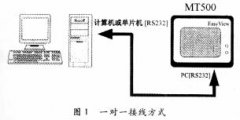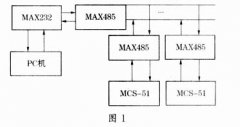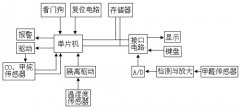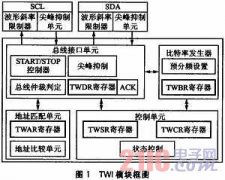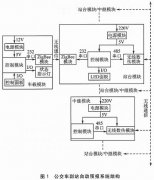单片机键盘的操作 -
[导读]键盘的应用和分类:键盘分为编码键盘和非编码键盘,键盘上闭合键的识别是由专门的硬件编码器实现,并产生键编码号或者是键值的成为编码键盘,如计算机的键盘靠软件编程来识别的称为非编码键盘;在单片机组成的各种系
键盘的应用和分类:
本文引用地址: http://www.21ic.com/app/mcu/201809/783053.htm
键盘分为编码键盘和非编码键盘,键盘上闭合键的识别是由专门的硬件编码器实现,并产生键编码号或者是键值的成为编码键盘,如计算机的键盘
靠软件编程来识别的称为非编码键盘;
在单片机组成的各种系统中,用的最多的是非编码键盘,也有用到编码键盘的
非编码键盘又有独立键盘和矩阵键盘。
要先像键盘里面先写1;在读取操作
示例代码:
#include
#define uint unsigned int
#define uchar unsigned char
sbit ld1 = P1^0;
sbit key1 = P3^4;
sbit dula = P2^6;
sbit wela = P2^7;
uchar num;
uchar code table[]={0x3f,0x06,0x5b,0x4f,
0x66,0x6d,0x7d,0x07,
0x7f,0x6f,0x77,0x7c,
0x39,0x5e,0x79,0x71};
void display(num);
main()
{
P3 = 0xff;
while(1)
{
display(num);
if(key1==0)
{
ld1 = 0;
num++;
if(num==10)
num = 0;
while(key1!=1);//松手检测
}
else
ld1 = 1;
}
}
void display(num)
{
wela = 1;
P0 = 0xfe;
wela = 0;
P0 = 0x0;
dula = 1;
P0 = table[num];
dula = 0;
dula = 1;//关灯操作
P0 = 0x0;
dula = 0;
}
View Code
这个程序看上去无懈可击,但是在实际过程中,有一个相当大打bug,那就是,你按住键盘的时候,数码管不显示数字,这不是很坑爹,所以,位选信号是开始就要打开的正确的代码是
#include
#define uint unsigned int
#define uchar unsigned char
sbit ld1 = P1^0;
sbit key1 = P3^4;
sbit dula = P2^6;
sbit wela = P2^7;
uchar num;
uchar code table[]={0x3f,0x06,0x5b,0x4f,
0x66,0x6d,0x7d,0x07,
0x7f,0x6f,0x77,0x7c,
0x39,0x5e,0x79,0x71};
void display(num);
main()
{
P3 = 0xff;
wela = 1;
P0 = 0xfe;//打开位选线
wela = 0;
while(1)
{
if(key1==0)
{
ld1 = 0;
num++;
if(num==10)
num = 0;
while(key1!=1);//松手检测
}
else
ld1 = 1;
dula = 1;
P0 = table[num];//在循环中不断送入段选
dula = 0;
}
}
去抖:由于按键接触的时候会出现抖动,所以,要进行去抖操作
去抖有硬件消抖和软件消抖
硬件消抖要用专门的硬件消抖电路,导致外部电路复杂,在单片机中用不着
软件消抖,一般是延时5毫秒检测
#include
#define uint unsigned int
#define uchar unsigned char
sbit ld1 = P1^0;
sbit key1 = P3^4;
sbit dula = P2^6;
sbit wela = P2^7;
uchar num;
uchar code table[]={0x3f,0x06,0x5b,0x4f,
0x66,0x6d,0x7d,0x07,
0x7f,0x6f,0x77,0x7c,
0x39,0x5e,0x79,0x71};
void delay(uint x);
main()
{
P3 = 0xff;
wela = 1;
P0 = 0xfe;//打开位选线
wela = 0;
while(1)
{
if(key1==0)
{
delay(10);//延时十毫秒
if(key1 == 0)//确实按下去了
{
ld1 = 0;
num++;
if(num==10)
num = 0;
while(key1!=1);//松手检测
delay(10); //检测是否松手
while(!key1);
}
}
else
ld1 = 1;
dula = 1;
P0 = table[num];//在循环中不断送入段选
dula = 0;
}
}
void delay(uint x)
{
uint y,z;
for(y=x;y>0;y--)
for(z=110;z>0;z--);
}
矩阵键盘:无论是矩阵键盘还是独立键盘,单片机检测其是否被按下去的依据都是一样的,也就是检测该键盘对应的I/O口是否为低电平,独立键盘有一段固定是低电平,单片机写程序时检测比较方便,电路时矩阵键盘的两端都与单片机deI/O口相连,因此在检测时,先送入一列为低电平,其余的全部为高电平,此时我们确定了列数,然后立即轮流检测一次各行是否有低电平,检测到某一行为低电平(这是我们有确定了行数),着我们便可确定是哪一行哪一列的按键被按下去。
示例代码:
#include
sbit wela =P2^6;
sbit dula = P2^7;
#define uchar unsigned char
#define uint unsigned int
void delay(uint z);
uchar num,num1,temp;
uchar keyscan();
uchar code table[]={0x3f,0x06,0x5b,0x4f,
0x66,0x6d,0x7d,0x07,
0x7f,0x6f,0x77,0x7c,
0x39,0x5e,0x79,0x71,0x0};
main()
{
wela = 1;
P0 = 0x0;
wela = 0;
while(1)
{
num1 = keyscan();
dula =1;
P0 = table[num1];
dula = 0;
}
}
void delay(uint z)
{
uint x,y;
for(x=z;x>0;x--)
for(y=110;y>0;y--);
}
uchar keyscan()
{
P3 = 0xfe;//1111 1110
temp = P3;
temp = temp&0xf0;//11110000
while(temp!=0xf0)//如果有键摁下
{
delay(5);//再次检测P3口
temp = P3;
temp = temp&0xf0;
while(temp!=0xf0)
{
temp = P3;
switch(temp)
{
case 0x7e:num = 1;
break;
case 0xbe:num = 2;
break;
case 0xde:num = 3;
break;
case 0xee:num = 4;
break;
}
while(temp!=0xf0)//松手检测
{
temp = P3;
temp = temp&0xf0;
}
}
}
P3 = 0xfd;//1111 1101
temp = P3;
temp = temp&0xf0;//11110000
while(temp!=0xf0)//如果有键摁下
查看评论 回复
"单片机键盘的操作 -"的相关文章
- 上一篇:stm32f103初学之见 -
- 下一篇:单片机的调试的快捷方式 -

